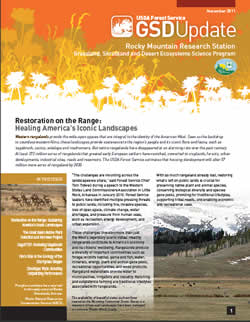Welcome to the Rocky Mountain Research Station
- Invasive Species Newsletter
- Federal Direction for Invasive Species Management
- Review of the Forest Service Response: The Bark Beetle Outbreak in Northern Colorado and Southern Wyoming
- Joint Fire Science Program, currently featuring extreme fire behavior.
What's New
Invasive Species Newsletter
The December issue of RMRS Invasive Species Science Update (ISSU) is now available. ISSU is produced by the RMRS Invasive Species Working Group (ISWG) which is a core group of scientists who volunteer to coordinate outreach of RMRS invasive species science to managers and the public. Back issues of the newsletter are at the working group's website.
Federal Direction for Invasive Species Management
The Forest Service has announced its first ever national-level direction on the management of invasive species. “Invasive species cost the American public an estimated $138 billion each year. They deplete water supplies, destroy recreation opportunities and damage landscapes across the country,” said U.S. Forest Service Chief Tom Tidwell. The final policy published in the Federal Register on December 5 reflects the consideration of comments received from a wide variety of stakeholders in the public and private sectors.
Review of the Forest Service Response: The Bark Beetle Outbreak in Northern Colorado and Southern Wyoming

A mountain pine beetle outbreak in three national forests in the
Rocky Mountain Region (Region 2) of the U.S. Forest Service — the
Arapaho-Roosevelt, Medicine Bow-Routt and White River — was initially
detected in 1996. By 2010 it had spread to about four million acres. This
report
examines the ecological conditions and historical land use that contributed to the outbreak, management response to the outbreak, suggested new and extended authorities for addressing the outbreak, and what we might expect as we look forward to the "new forest".
Read more...
GSDUpdate: Restoration on the Range: Healing America’s Iconic Landscapes

Western rangelands provide the wide-open spaces that are integral to the identity of the American West. Seen as the backdrop to countless western films, these landscapes provide sustenance to the region’s people and its iconic flora and fauna, such as sagebrush, cactus, antelope and roadrunners. But native rangelands have disappeared at an alarming rate over the past century. At least 272 million acres of rangelands that greeted early European settlers have vanished, converted to croplands, forests, urban developments, industrial sites, roads and reservoirs.
“I believe that Americans who love their public lands can coalesce around the common goal of ecological restoration,” says Chief Tidwell. Tidwell has developed an approach that emphasizes stewardship on a scale that supersedes ownership. “An all-lands approach brings landowners and stakeholders together across boundaries to decide on common goals for the landscapes they share,” he says.
Read more...
Priest River Experimental Forest Centennial Celebration

From October 6-8, the Station’s Priest River Experimental Forest (PREF) in northern Idaho was buzzing with over 100 visitors, scientists, retirees, cooperators and others sharing in the excitement of celebrating a “century of science.” Established in 1911, after the great fires of 1910, PREF is one of the first experimental forests set aside for forestry research in the U.S.
A persistent drizzle and cool temperatures couldn’t dampen the enthusiasm of meeting old friends, reminiscing about old times, and sharing in the bold research programs at PREF over the past century.
Read more...
Fourmile Canyon Fire Preliminary Findings

On September 15, 2010, Senator Mark Udall requested a
study
of the
Fourmile Canyon Fire similar to one he requested after the
Hayman Fire in 2002 with the intent of gaining useful information on
how we might better respond to and mitigate the potential devastation
of future wildfires in the Front Range.
This
assessment
represents the preliminary scientific findings;
once it is finalized, the methods, results, and conclusions will be
peer reviewed to meet the quality standards of
Forest Service Research and Development prior to
publication by the Rocky Mountain Research Station.
Flame Wall & Fire Ignition Bench
The work of two scientists from RMRS Fire Sciences Lab were featured on the Discovery Channel's Daily Planet show:
- Research forester Mark Finney’s Flame Wall, which is an apparatus for studying flame characteristics. Mark was not available for the interview so the interview was conducted with Jack Cohen, Fire Sciences Lab research physical scientist.
- Ecologist Matt Jolly’s Fire Ignition Bench, which measures properties of radiant versus convective heat using live vegetation with live fuel moistures. Matt was interviewed for this segment.
The Tangled Web of Montana Spiders
Wildlife and Terrestrial Ecosystems Program scientist Dean Pearson was interviewed by Ari Shapiro for Living on Earth concerning The Tangled Web of Montana Spiders. The spot aired on National Public Radio the week of September 30, 2011.
To learn more about Dean's research visit Ecology and Management of Invasive Species.
Recent Publications
Visit Publications for access to all station publications. Printed copies of all station publications can be ordered free of charge.
For externally refereed publications, visit either

